The arch top door market is expected to grow from USD 335.8 million in 2025 to USD 447.0 million by 2035, supported by expanding architectural design preferences and increased investment in premium building finishes. In the first half of the period, growth is driven primarily by residential construction and small-to-medium commercial projects where curb appeal, façade uniformity, and stylistic detailing influence door selection. Standardization of customized arch profiles, improved CNC wood shaping, and expanded finish options continue to make arch top doors more accessible to mid-range construction budgets, rather than being limited to luxury and heritage properties.
From 2030 to 2035, the market is expected to grow from USD 387.4 million to USD 447.0 million, contributing USD 59.6 million, or 54 percent of the total decade expansion. This phase will feature greater adoption across mixed-use developments, boutique commercial buildings, hospitality interiors, and restoration projects where architectural aesthetics play a prominent role. The integration of engineered wood cores, thermally improved framing, and multi-point locking systems will enhance structural performance and energy efficiency, aligning arch top doors with evolving building code and sustainability requirements. Manufacturers that offer modular sizing, factory pre-finishing, and streamlined installation kits are positioned to gain a competitive advantage as builders prioritize reduced labor time and design consistency across large-scale construction portfolios.

The subsequent period from 2030 to 2035 extends growth from USD 387.4 million to USD 447.0 million, adding USD 59.6 million or 54% of the decade's total expansion. This phase centers on widespread market penetration of interior door applications, enhanced integration with architectural design platforms, and expanded compatibility with diverse building construction standards. Market development signals fundamental shifts in how builders and architects approach entryway design optimization and aesthetic differentiation, with industry participants positioned to capture demand across multiple door type categories and application segments.
The arch top door market demonstrates distinct growth phases with varying market characteristics and competitive dynamics. Between 2025 and 2030, the market advances through its adoption acceleration phase, expanding from USD 335.8 million to USD 387.4 million with steady annual increments averaging 2.9% growth. This period showcases the transition from specialized architectural applications to mainstream residential and commercial building integration, with enhanced customization capabilities and design flexibility becoming standard features.
The 2025-2030 phase contributes USD 51.6 million to market value, representing 46% of total decade expansion. Market maturation factors include standardization of architectural design protocols, declining manufacturing costs for customized door configurations, and increasing builder awareness of aesthetic differentiation benefits reaching diverse construction segments. Competitive landscape evolution during this period features established door manufacturers expanding their architectural door portfolios while specialty woodworking companies focus on premium customization capabilities.
From 2030 to 2035, market dynamics shift toward comprehensive application diversification and enhanced design integration, with growth continuing from USD 387.4 million to USD 447.0 million, adding USD 59.6 million or 54% of total expansion. This phase transition centers on interior door adoption, integration with residential renovation projects, and deployment across commercial building applications. The competitive environment matures with focus shifting from basic door manufacturing capability to comprehensive architectural solution systems.
| Metric | Value |
|---|---|
| Market Value (2025) | USD 335.8 million |
| Market Forecast (2035) | USD 447.0 million |
| Growth Rate | 2.9% CAGR |
| Leading Technology | Entry Doors |
| Primary Application | Commercial Segment |
The market demonstrates solid fundamentals with entry door systems capturing a dominant share through advanced design capabilities and architectural integration. Commercial applications drive primary demand, supported by increasing construction activity and architectural differentiation requirements. Geographic expansion remains concentrated in developed markets with established building infrastructure, while emerging economies show accelerating adoption rates driven by residential construction expansion and rising design standards.
Market expansion rests on three fundamental shifts driving adoption across residential, commercial, and architectural sectors. First, architectural differentiation creates compelling design advantages through arch top doors that provide immediate visual distinction and aesthetic enhancement without compromising structural integrity, enabling builders to meet sophisticated design standards while maintaining construction efficiency. Second, residential construction modernization accelerates as homebuilders worldwide seek distinctive entryway solutions that complement contemporary design processes, enabling precise customization and quality presentation that align with buyer expectations.
Third, commercial building enhancement drives adoption from property developers and building contractors requiring effective architectural elements that maximize property value while maintaining operational practicality during installation operations. Growth faces headwinds from manufacturing cost challenges that vary across door suppliers regarding custom fabrication requirements and specialty materials, which may limit adoption in cost-sensitive construction environments. Technical limitations persist regarding installation complexity and structural accommodation requirements that may reduce effectiveness in retrofit applications, affecting project feasibility and construction timelines.
The arch top door market represents a specialized architectural opportunity driven by expanding residential construction, commercial building modernization, and demand for distinctive entryway solutions across diverse building applications. As builders worldwide seek to achieve architectural differentiation, enhance property aesthetics, and integrate premium door systems with construction platforms, arch top doors evolve from specialty architectural elements to mainstream design solutions ensuring visual distinction and quality positioning.
The market's growth trajectory from USD 335.8 million in 2025 to USD 447.0 million by 2035 at a 2.9% CAGR reflects fundamental shifts in building design requirements and architectural differentiation strategies. Geographic expansion opportunities remain particularly pronounced in Asia Pacific markets, while the dominance of entry door systems and commercial applications provides clear strategic focus areas.
Strengthening the dominant entry door segment through enhanced design capabilities, superior customization options, and integrated manufacturing systems. This pathway focuses on optimizing door configurations, improving aesthetic presentation, extending operational effectiveness across diverse architectural styles, and developing specialized designs for varied applications. Market leadership consolidation through advanced manufacturing engineering and design integration enables premium positioning while defending competitive advantages. Expected revenue pool: USD 45-60 million
Rapid residential construction and commercial building growth across Asia Pacific creates substantial expansion opportunities through local manufacturing capabilities and distribution partnerships. Growing construction activity and architectural sophistication drive demand for distinctive door systems. Regional strategies reduce import costs, enable faster project support, and position companies advantageously for builder procurement programs. Expected revenue pool: USD 38-52 million
Expansion within the commercial segment through specialized door designs addressing building standards and project specifications. This pathway encompasses installation system integration, quality control coordination, and compatibility with diverse construction processes. Premium positioning reflects superior architectural presentation and comprehensive building code compliance. Expected revenue pool: USD 32-44 million
Strategic expansion into interior door applications requires enhanced design capabilities and manufacturing flexibility addressing residential renovation requirements. This pathway addresses space optimization, design coordination, and architectural consistency with advanced customization for demanding interior applications. Premium pricing reflects specialized design requirements. Expected revenue pool: USD 28-38 million
Development of specialized door systems for residential applications addressing homeowner preferences and builder specifications. This pathway encompasses design personalization, material optimization, and cost-effective solutions for residential construction segments. Technology differentiation through proprietary manufacturing enables diversified revenue streams. Expected revenue pool: USD 24-33 million
Primary Classification: The market segments by door type into Entry Doors, Interior Doors, and Others categories, representing evolution from basic door applications to specialized architectural solutions for comprehensive building optimization.
Secondary Classification: Application segmentation divides the market into Commercial and Residential sectors, reflecting distinct requirements for building specifications, design capacity, and architectural presentation standards.
Regional Classification: Geographic distribution covers Asia Pacific, Europe, North America, and other regions, with developed markets leading adoption while emerging economies show accelerating growth patterns driven by construction expansion programs.
The segmentation structure reveals progression from standard door designs toward specialized architectural systems with enhanced customization and aesthetic capabilities, while application diversity spans from commercial building projects to residential construction requiring precise door solutions.
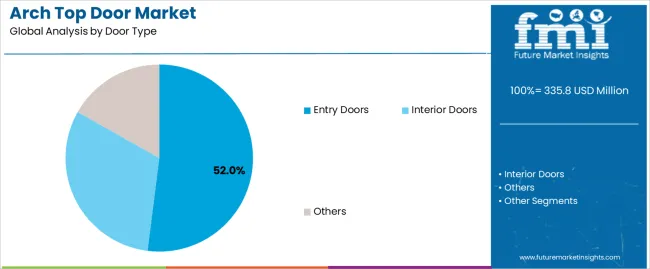
Market Position: Entry door systems command the leading position in the arch top door market with approximately 52.0% market share through advanced design properties, including superior aesthetic impact, architectural prominence, and customization capability that enable builders to achieve optimal visual differentiation across diverse residential and commercial environments.
Value Drivers: The segment benefits from builder preference for distinctive door systems that provide consistent architectural enhancement, immediate curb appeal impact, and design differentiation without requiring significant structural modifications. Advanced design features enable installation flexibility, aesthetic consistency, and integration with existing building specifications, where door performance and visual impact represent critical project requirements.
Competitive Advantages: Entry door systems differentiate through proven design versatility, consistent quality characteristics, and integration with standard construction practices that enhance project effectiveness while maintaining optimal aesthetics suitable for diverse architectural applications.
Key market characteristics:
Interior door systems maintain significant market positioning in the arch top door market due to their design versatility and residential application advantages. These systems appeal to builders requiring distinctive door solutions with adequate performance for interior architectural applications. Market adoption is driven by residential renovation expansion, emphasizing design coordination and aesthetic consistency through optimized door manufacturing while maintaining competitive pricing structures.

Market Context: Commercial applications dominate the arch top door market with approximately 58.0% market share due to widespread adoption of architectural door systems and increasing focus on building aesthetics, design differentiation, and property value enhancement that minimize architectural uniformity while maintaining construction standards.
Appeal Factors: Commercial developers prioritize design impact, aesthetic consistency, and integration with existing building specifications that enable coordinated door application across multiple project types. The segment benefits from substantial construction investment and development programs that emphasize acquisition of distinctive door systems for property differentiation applications.
Growth Drivers: Commercial construction programs incorporate arch top doors as standard architectural elements for premium building operations, while mixed-use development growth increases demand for distinctive entryway capabilities that comply with building codes and enhance property positioning.
Market Challenges: Varying construction standards and building code differences may limit door standardization across different project types or regional scenarios.
Application dynamics include:
Residential applications capture approximately 42.0% market share through specialized door requirements in home construction, renovation projects, and custom home building applications. These facilities demand reliable door systems capable of providing aesthetic enhancement while delivering functional performance and homeowner satisfaction.
Growth Accelerators: Residential construction expansion drives primary adoption as arch top doors provide superior aesthetic differentiation capabilities that enable homebuilders to meet design standards without excessive construction costs, supporting property operations and development objectives that require distinctive entryway applications. Architectural design demand accelerates market expansion as builders seek effective customization systems that enhance visual impact while maintaining operational effectiveness during construction and installation scenarios. Construction industry spending increases worldwide, creating demand for architectural door systems that complement traditional building processes and provide design differentiation in competitive markets.
Growth Inhibitors: Manufacturing cost challenges vary across door suppliers regarding custom fabrication requirements and specialty materials, which may limit operational flexibility and market penetration in regions with price-sensitive construction operations. Technical performance limitations persist regarding installation complexity and structural accommodation that may reduce effectiveness in retrofit, renovation, or constrained space conditions, affecting project feasibility and construction requirements. Market fragmentation across multiple building codes and architectural specifications creates compatibility concerns between different door manufacturers and existing construction infrastructure.
Market Evolution Patterns: Adoption accelerates in premium residential and commercial construction sectors where architectural differentiation justifies door costs, with geographic concentration in developed markets transitioning toward mainstream adoption in emerging economies driven by construction expansion and design sophistication. Technology development focuses on enhanced manufacturing techniques, improved customization capabilities, and compatibility with standard construction systems that optimize aesthetic impact and installation effectiveness. The market could face disruption if alternative entryway designs or modular door technologies significantly limit deployment of arch top configurations in building applications, though the design's unique combination of aesthetic distinction, architectural character, and visual impact continues making it preferred in premium construction.
The arch top door market demonstrates varied regional dynamics with Growth Leaders including China (3.9% CAGR) and India (3.6% CAGR) driving expansion through residential construction capacity additions and architectural sophistication programs. Steady Performers encompass Germany (3.3% CAGR), Brazil (3.0% CAGR), and United States (2.8% CAGR), benefiting from established construction industries and advanced design adoption. Mature Markets feature United Kingdom (2.5% CAGR) and Japan (2.2% CAGR), where specialized architectural applications and premium building integration support consistent growth patterns.

| Country | CAGR (2025-2035) |
|---|---|
| China | 3.9% |
| India | 3.6% |
| Germany | 3.3% |
| Brazil | 3.0% |
| United States | 2.8% |
| United Kingdom | 2.5% |
| Japan | 2.2% |
Regional synthesis reveals Asia Pacific markets leading adoption through residential construction expansion and architectural design advancement, while European countries maintain steady expansion supported by building renovation programs and design standardization requirements. North American markets show moderate growth driven by residential construction applications and architectural integration trends.
The Chinese market emphasizes advanced design features, including precision customization and integration with comprehensive construction platforms that manage quality control, aesthetic optimization, and installation applications through coordinated building systems. The country demonstrates strong growth at 3.9% CAGR, driven by residential construction expansion, architectural sophistication initiatives, and emerging premium property development that support door system integration. Chinese builders prioritize operational effectiveness with arch top doors delivering consistent design presentation through advanced manufacturing capabilities and construction adaptation features.
Distribution channels include major construction companies, specialized door distributors, and building material procurement programs that support professional applications for residential construction and commercial building projects. Manufacturing platform integration capabilities with established construction systems expand market appeal across diverse project requirements seeking aesthetic differentiation and quality benefits. The expanding middle-class housing demand and accelerating premium residential market create demand, while innovative applications in commercial construction and mixed-use developments open new growth avenues.
Performance Metrics:
Germany's advanced construction market demonstrates sophisticated door deployment with documented operational effectiveness in residential building applications and commercial construction facilities through integration with existing building systems and architectural infrastructure. The country leverages engineering expertise in manufacturing precision and construction systems integration to maintain strong growth at 3.3% CAGR. Industrial centers, including Frankfurt, Munich, and Hamburg, showcase premium installations where door systems integrate with comprehensive construction platforms and building management systems to optimize project quality and architectural effectiveness.
German door manufacturers prioritize system quality and construction compliance in product development, creating demand for premium door systems with advanced features, including customization integration and quality verification systems. The market benefits from established construction infrastructure and willingness to invest in architectural elements that provide long-term property benefits and compliance with building standards.
Market Intelligence Brief:
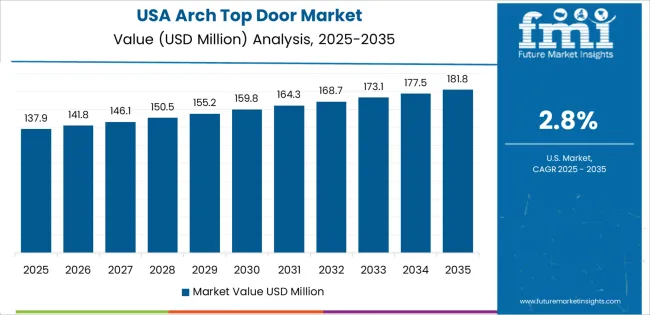
The USA arch top door market demonstrates sophisticated deployment across residential construction applications with documented effectiveness in custom home building and commercial property facilities through integration with comprehensive architectural platforms and construction infrastructure. The country leverages advanced manufacturing capabilities in design innovation and customization technologies to maintain moderate growth at 2.8% CAGR. Construction centers, including major metropolitan areas, showcase premium installations where door systems integrate with comprehensive building platforms and distribution networks to optimize design positioning and construction effectiveness.
American builders prioritize design flexibility and architectural differentiation in door selection, creating demand for innovative door systems with advanced features, including custom finishing integration and installation optimization. The market benefits from established residential construction infrastructure and willingness to invest in architectural elements that provide property value enhancement and compliance with building codes.
Market Intelligence Brief:
The UK arch top door market demonstrates advanced renovation deployment with documented operational effectiveness in residential renovation applications and period property restoration through integration with existing architectural systems and construction infrastructure. The country leverages expertise in building preservation and construction systems integration to maintain steady growth at 2.5% CAGR. Construction centers, including London, Manchester, and Birmingham, showcase installations where door systems integrate with renovation platforms and architectural restoration systems to optimize heritage compliance and construction effectiveness.
British builders prioritize system compatibility and architectural appropriateness in door development, creating demand for specialized door systems with advanced features, including period-appropriate design and restoration integration. The market benefits from established renovation infrastructure and commitment to invest in architectural elements that provide property enhancement and compliance with conservation standards.
Strategic Market Indicators:
Arch top door market in India demonstrates rapid expansion with documented operational effectiveness in residential construction applications and commercial building facilities through integration with emerging construction systems and development infrastructure. The country leverages growing manufacturing capabilities in door production and construction systems integration to achieve high growth at 3.6% CAGR. Construction centers, including Mumbai, Delhi, and Bangalore, showcase expanding installations where door systems integrate with comprehensive building platforms and distribution networks to optimize market penetration and construction effectiveness.
Indian builders prioritize design impact and quality standards in door selection, creating demand for sophisticated door systems with advanced features, including customization integration and quality control systems. The market benefits from expanding residential construction infrastructure and willingness to invest in architectural elements that provide property differentiation and compliance with building standards.
Market Intelligence Brief:
Arch top door market in Brazil demonstrates expansion with documented operational effectiveness in residential construction applications and commercial development facilities through integration with growing construction systems and building infrastructure. The country leverages developing manufacturing capabilities in door production and construction integration to achieve growth at 3.0% CAGR. Construction centers, including São Paulo, Rio de Janeiro, and Brasília, showcase installations where door systems integrate with building platforms and distribution networks to optimize market development and construction effectiveness.
Brazilian builders prioritize design value and construction efficiency in door selection, creating demand for cost-effective door systems with reliable features, including standard customization and installation compatibility. The market benefits from expanding construction infrastructure and investment in architectural elements that provide property enhancement.
Market Intelligence Brief:
Arch top door market in Japan demonstrates precision deployment with documented operational effectiveness in premium residential construction applications and specialty building facilities through integration with advanced manufacturing systems and quality control infrastructure. The country leverages engineering excellence in precision manufacturing and construction systems integration to maintain steady growth at 2.2% CAGR. Construction centers, including Tokyo, Osaka, and Yokohama, showcase installations where door systems integrate with comprehensive quality platforms and construction management systems to optimize building excellence and architectural effectiveness.
Japanese builders prioritize system precision and manufacturing excellence in door development, creating demand for premium door systems with advanced features, including precision fabrication and quality integration systems. The market benefits from established construction infrastructure and commitment to invest in highest-quality architectural elements that provide superior property positioning and compliance with rigorous building standards.
Strategic Market Indicators:
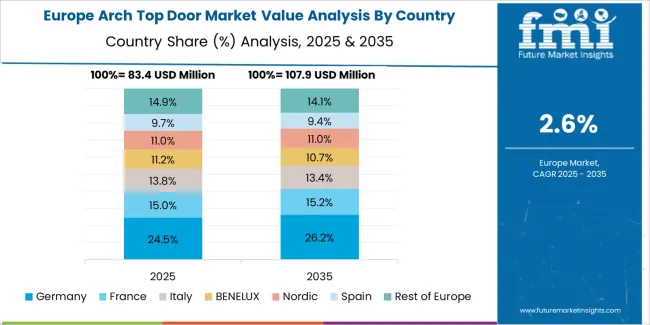
The arch top door market in Europe is projected to grow from USD 87.3 million in 2025 to USD 122.6 million by 2035, registering a CAGR of 3.4% over the forecast period. Germany is expected to maintain its leadership position with a 28.5% market share in 2025, projected to reach 29.2% by 2035, supported by its advanced construction infrastructure and major building centers in Frankfurt and Munich. France follows with a 19.7% share in 2025, expected to reach 20.3% by 2035, driven by comprehensive architectural renovation programs and residential construction initiatives. The United Kingdom holds a 16.4% share in 2025, projected to reach 16.8% by 2035 through specialized renovation activities and period property restoration applications. Italy commands a 13.8% share, while Spain accounts for 11.2% in 2025. The Netherlands maintains an 4.6% share. The Rest of Europe region is anticipated to show steady adoption, with its collective share remaining at 5.8% through 2035, reflecting consistent growth in Nordic countries and emerging Central European construction markets implementing architectural enhancement programs.

In Japan, the arch top door market prioritizes entry door systems, which capture the dominant share of residential construction and commercial building installations due to their advanced features, including precision aesthetic optimization and seamless integration with existing building infrastructure. Japanese builders emphasize quality, craftsmanship, and long-term performance excellence, creating demand for entry door systems that provide consistent architectural capabilities and superior design presentation based on construction requirements and aesthetic standards. Interior doors maintain secondary positions primarily in residential renovation applications and custom home installations where comprehensive architectural functionality meets operational requirements without compromising construction efficiency.
Market Characteristics:
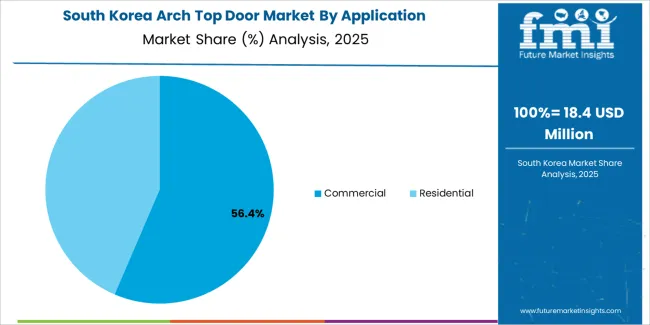
In South Korea, the market structure favors international door manufacturers, including TruStile Doors, Pella, and JELD-WEN, which maintain dominant positions through comprehensive product portfolios and established builder networks supporting both residential construction and commercial building installations. These providers offer integrated solutions combining advanced door systems with professional design services and ongoing technical support that appeal to Korean builders seeking reliable architectural door systems. Local door contractors and woodworking studios capture moderate market share by providing localized service capabilities and competitive pricing for standard building applications, while domestic manufacturers focus on specialized applications and cost-effective solutions tailored to Korean construction market characteristics.
Channel Insights:
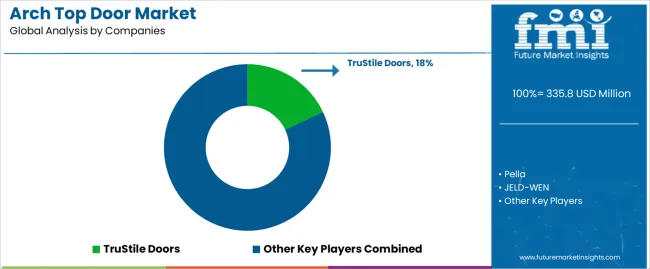
The arch top door market operates with moderate concentration, featuring approximately 15-20 meaningful participants, where leading companies control roughly 40-45% of the global market share through established builder relationships and comprehensive door product portfolios. Competition emphasizes advanced design capabilities, manufacturing quality, and construction integration rather than price-based rivalry. The leading company, TruStile Doors, commands approximately 18.0% market share through its extensive architectural door product line and construction industry presence.
Market Leaders encompass TruStile Doors, Pella, and JELD-WEN, which maintain competitive advantages through extensive door manufacturing expertise, established builder networks, and comprehensive design integration capabilities that create customer loyalty and support premium positioning. These companies leverage decades of woodworking technology experience and ongoing innovation investments to develop advanced door systems with precision design control and quality features. Technology Innovators include Allegheny Wood Works and regional specialists, which compete through specialized manufacturing focus and innovative design capabilities that appeal to builders seeking advanced architectural solutions and design differentiation.
These companies differentiate through rapid customization cycles and specialized residential construction application focus. Regional Specialists feature door manufacturers focusing on specific geographic markets and specialized applications, including custom woodworking systems and integrated architectural solutions. Market dynamics favor participants that combine reliable manufacturing quality with advanced design capabilities, including precision aesthetic control and customization optimization features. Competitive pressure intensifies as traditional door manufacturers expand into architectural door systems, while specialized woodworking companies challenge established players through innovative design solutions and customization platforms targeting premium residential and commercial construction segments.
| Item | Value |
|---|---|
| Quantitative Units | USD 335.8 million |
| Door Type | Entry Doors, Interior Doors, Others |
| Application | Commercial, Residential |
| Regions Covered | Asia Pacific, Europe, North America, Latin America, Middle East & Africa |
| Countries Covered | China, India, Germany, Brazil, United States, United Kingdom, Japan, and 20+ additional countries |
| Key Companies Profiled | TruStile Doors, Pella, JELD-WEN, Allegheny Wood Works, Illingworth Millwork, Simpson Doors, Marvin Windows and Doors, Milgard, Therma-Tru Doors, Masonite, Plastpro, Steves & Sons |
| Additional Attributes | Dollar sales by door type and application categories, regional adoption trends across Asia Pacific, Europe, and North America, competitive landscape with door manufacturers and construction suppliers, builder preferences for design differentiation and architectural quality, integration with construction platforms and building management systems, innovations in manufacturing techniques and customization capabilities, and development of installation solutions with enhanced performance and construction optimization capabilities. |
The global arch top door market is estimated to be valued at USD 335.8 million in 2025.
The market size for the arch top door market is projected to reach USD 446.9 million by 2035.
The arch top door market is expected to grow at a 2.9% CAGR between 2025 and 2035.
The key product types in arch top door market are entry doors , interior doors and others.
In terms of application, commercial segment to command 58.0% share in the arch top door market in 2025.






Full Research Suite comprises of:
Market outlook & trends analysis
Interviews & case studies
Strategic recommendations
Vendor profiles & capabilities analysis
5-year forecasts
8 regions and 60+ country-level data splits
Market segment data splits
12 months of continuous data updates
DELIVERED AS:
PDF EXCEL ONLINE
Architectural Metal Coating Market Forecast Outlook 2025 to 2035
Architectural Membranes Market Size and Share Forecast Outlook 2025 to 2035
Architectural Flat Glass Market Size and Share Forecast Outlook 2025 to 2035
Architectural Lighting Market
Arch Top Casement Window Market Size and Share Forecast Outlook 2025 to 2035
Parchment Paper Market Size and Share Forecast Outlook 2025 to 2035
Search and Rescue Equipment (SAR) Market Size and Share Forecast Outlook 2025 to 2035
Starch-based Texturizing Agents Market Size and Share Forecast Outlook 2025 to 2035
Starch-based Packaging Market Size and Share Forecast Outlook 2025 to 2035
Starch-derived Fiber Market Size and Share Forecast Outlook 2025 to 2035
Starch-Based Bioplastics Packaging Market Insights - Growth & Forecast 2025 to 2035
Starch Derivatives Market by Product Type, Source, End Use and Region through 2035
Starches/Glucose Market
Starch Glucose Syrup Market
Starch Recovery Systems Market Outlook – Growth, Demand & Forecast 2023-2033
Distarch Phosphate Market Size and Share Forecast Outlook 2025 to 2035
Research And Development (R&D) Analytics Market Size and Share Forecast Outlook 2025 to 2035
Research Antibodies Market Size and Share Forecast Outlook 2025 to 2035
AI Search Engine Market Size and Share Forecast Outlook 2025 to 2035
UK Starch Derivatives Market Report – Size, Share & Innovations 2025-2035

Thank you!
You will receive an email from our Business Development Manager. Please be sure to check your SPAM/JUNK folder too.
Chat With
MaRIA